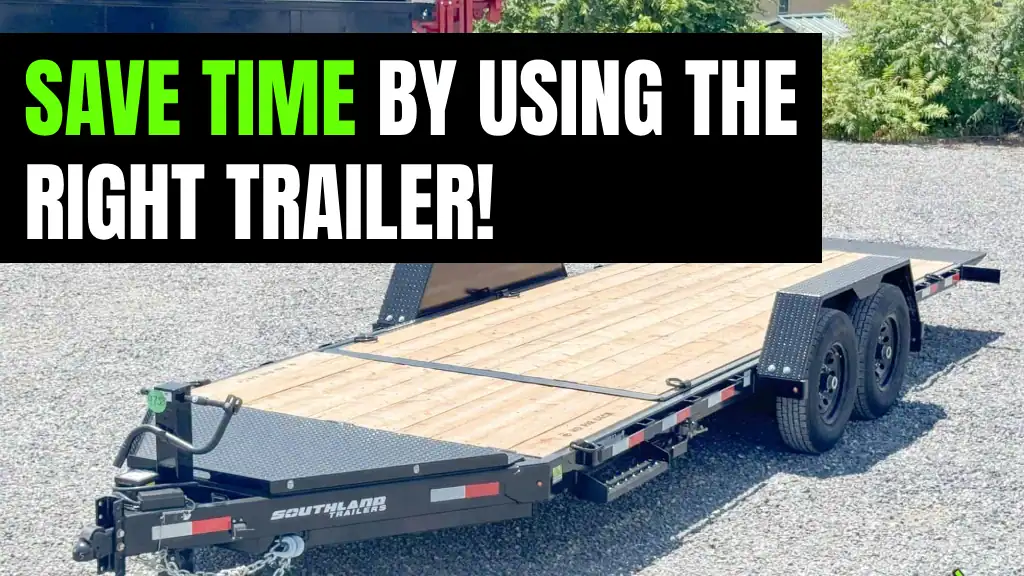Popular Searches:
Displaying top search terms based on the last 90 days.
Popular Searches:
Displaying top search terms based on the last 90 days.

Every minute your crew spends setting up ramps, struggling to load equipment, or waiting on the job site eats into productivity. Across a busy workday, those moments can add up to serious lost time. But with the right trailer setup, especially when it comes to the loading mechanism, you can reclaim up to 30 minutes or more each day. That’s time better spent finishing jobs, taking on extra work, or simply reducing the strain on your crew.
Whether you’re hauling mowers, mini-excavators, or utility equipment, your trailer setup plays a huge role in how smoothly the day goes. We’re going to break down how smarter trailer choices like tilt decks, flip-knee ramps, or integrated gates can dramatically improve your daily operations.
Some businesses still use flat-deck trailers with bolt-on ramps. These work fine, but they need setup, storage space, and manual handling every time you load. That means more time, more strain on your crew, and more opportunity for mistakes.
Tilt deck trailers, on the other hand, eliminate many of those delays. You tilt the deck once, drive equipment on, lock it in place, and go. Loading heavy equipment or riding mowers becomes faster and safer, especially when repeated across multiple jobsites.
In interviews and online reviews, many landscapers and small contractors shared how upgrading their trailer setups transformed their daily workflow. One crew explained that they were using traditional ramp trailers for years, unaware how much time it was costing them.
Once they switched to a tilt deck trailer with a built-in hydraulic assist, they immediately noticed faster loading times and less hassle. Their team no longer needed to fumble with bulky ramps or worry about positioning them correctly every time.
Another operator mentioned that moving from ladder ramps to flip-knee ramp systems helped their employees “zero in” equipment placement. This improved not only their speed, but also their accuracy with tie-downs, reducing the chance of shifting loads and making unloading quicker and safer.
Across multiple crews, a common theme emerged: consistency. With tilt decks or high-quality ramp systems, crews could rely on a predictable process that minimized wasted time and physical effort.
YouTube reviewers like Exmark and TrailerNerd have echoed similar results. They highlight that even small trailer upgrades can lead to massive productivity gains over time.
One landscaper stated, “We used to lose 10 to 15 minutes just setting up and putting away ramps. Switching to a tilt trailer cut that by half, and now we’re getting to jobs faster and wrapping up sooner.”
Your answers to these questions will clarify whether you require a tilt trailer, a landscape trailer with a side gate, flip-knee ramps, or full slide-in ramps.
The right trailer can streamline your day, reduce setup time, and protect your crew from unnecessary strain, especially with high-cycle jobs involving mowers, turf equipment, skids, or other gear.
If saving time, improving safety, and boosting daily efficiency matters to you, it’s worth exploring how tilt beds, flip-knee ramp systems, and landscape trailers with ramps or dovetails can pay off.
Still not sure what to use for your business? Give us a call or stop by to check out our inventory!
Tilt deck trailers often come at a higher upfront cost, typically $1,500 to $3,000 more than similar-sized ramp trailers. However, many businesses find that the time savings, lower physical strain, and increased safety offset the initial investment within the first year.
Not necessarily. While tilt trailers may include hydraulic systems or pivoting components, most are designed to be low-maintenance. Regular lubrication and basic inspections usually keep them running smoothly. Many manufacturers offer sealed systems that require minimal upkeep.
Start by timing how long it takes to load and unload equipment on your current trailer setup. If the process consistently takes more than five minutes and involves multiple manual steps, it’s likely that your team could benefit from a more streamlined system.
Yes. Steeper ramps increase the risk of slips or equipment misalignment, especially in wet or muddy conditions. Wider or fold-down ramps and tilt beds tend to provide safer angles and more stability, especially for low-clearance or heavy equipment.
In many cases, yes. Some trailers allow for upgraded ramp kits or add-on hydraulic tilt systems. However, it depends on the trailer frame, axle capacity, and deck height. It’s best to consult with a trailer expert to see what options fit your current setup.